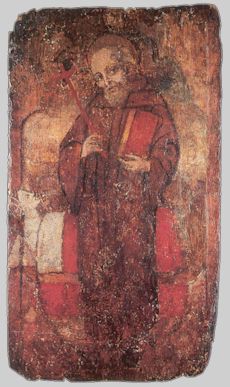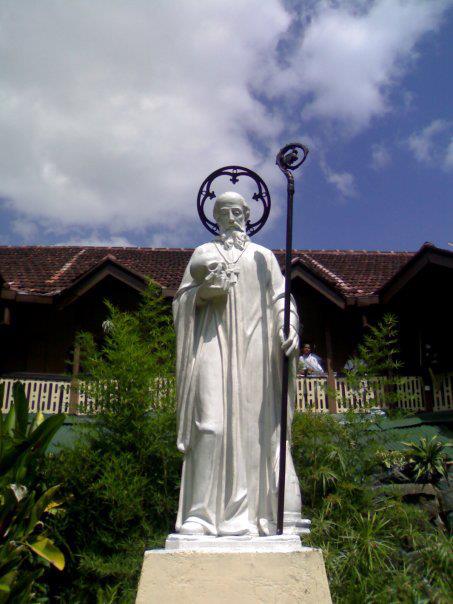Saint Silvestre Gozzolini
Abbé
à Fabiano en Italie Centrale (✝ 1267)
Il embrassa la vie
monastique pour se donner totalement au Christ et il fonda une nouvelle
congrégation bénédictine, dédiée également aux tâches apostoliques.
"Saint Silvestre, contemporain de saint François d'Assise, était, comme lui, destiné à se brouiller
avec son père, pour avoir suivi l'attrait de la grâce et obéi à sa vocation.
Il naquit à Osmo ou Osimo, dans la Marche d'Ancône, en 1177, de la noble
famille des Gozzolini...
Comme il était savant en théologie, l'évêque d'Osmo l'ordonna prêtre et lui
donna un canonicat dans sa cathédrale. Notre saint s'adonna avec succès à la
prédication...
Placé, comme autrefois saint Bruno,
près d'un évêque scandaleux et incorrigible, il n'éprouva plus, comme
lui, que du dégoût pour le monde et résolut de le quitter.
Il s'enfuit secrètement avec un guide, et alla se cacher seul dans un désert, à
dix lieues d'Osimo. Il avait alors quarante ans. Il vécut là de la manière la
plus pauvre et dans de grandes austérités...
Malgré le soin qu'il avait de se cacher, il lui vint des disciples, qui lui
demandèrent à vivre sous sa conduite. Il bâtit avec eux un monastère sur le
mont Fano, près de Fabriano, dans la Marche d'Ancône, en 1231 , et y jeta les
fondements de son ordre, qui prit d'abord le nom de Monte-Fano, et il donna à
ses moines la règle de saint Benoît, leur recommandant surtout la plus grande
pauvreté, à l'instar des franciscains...
Saint Silvestre, dont la vie fut longue, fonda lui-même une douzaine de
monastères de son ordre, et mourut dans celui de Monte-Fano, le 26 novembre
1267, à l'âge de quatre-vingt-dix ans: ce qui prouve que les austérités
n'abrégent pas toujours l'existence des hommes. Clément VIII, né à Fano, et
élevé sur la chaire de saint Pierre, en 1592, mit le nom de Silvestre dans le
martyrologe romain."
Près de Fabriano dans les Marches, en 1267, saint Silvestre Gozzolini,
abbé. Devant la tombe ouverte d’un ami qui venait de mourir, il comprit toute
la vanité du monde et se retira dans la solitude. Après avoir changé plusieurs
fois de lieu, pour mieux se cacher des hommes, il finit dans un lieu désert, à
Monte Fano, par jeter les fondements de la Congrégation des Silvestrins,
sous la Règle de saint Benoît.
Martyrologe
romain
Saint Sylvestre naquit de nobles parents à Osimo, dans la Marche
d’Ancône. Son rare mérite engagea les chanoines de la cathédrale d’Osimo à
l’associer à leur dignité.
Assistant un jour aux funérailles
d’un homme illustre, son parent, et considérant dans le cercueil découvert le
cadavre hideux de cet homme autrefois remarquable par sa beauté, il se
dit : « Je suis aujourd’hui ce qu’il fut ; un jour je serai ce
qu’il est ».
Aussitôt il quitta tout et se
retira dans un désert où il s’adonna à la pénitence et à la méditation.
« Il éleva plus tard à
Monte-Fano, dit le Bréviaire Romain, une église en l’honneur du très
saint Père Benoît qui lui conseilla dans une vision de fonder un ordre
religieux dont il lui indiqua la règle et l’habit. C’est l’Ordre des Sylvestrins ».
Cette
branche de l’Ordre bénédictin se propagea en peu de temps et comptait déjà
vingt-cinq maisons en Italie, lorsque son saint Fondateur mourut en 1267, à
l’âge de quatre vingt-dix ans.
Silvester Gozzolini, OSB Abbot (RM)
Born at Osimo, Italy, 1177; died at Monte Fano, 1267; equivalently canonized in
1598 by Pope Clement VIII.
Born of a noble
family, Saint Silvester studied law at Bologna and Padua, but, against his
father's wishes, switched to the study of theology and Scripture. He was
ordained and became a canon in the cathedral of his home town of Osima until he
was 50. Then he respectfully, but firmly, rebuked his bishop for the dissolute
life he was leading. Silvester resigned his benefice in 1227, and became a
hermit 30 miles from Osimo. Here he lived in poverty and discomfort until the
landowner gave him a better hermitage. This one proved to be too damp, so he
moved to Grotta Fucile, where he lived an extremely penitential life until
1231.
Directed by a
vision of Saint Benedict, he organized the disciples he had attracted into a
monastery at Monte Fano near Fabriano in the Marches of Ancona, thus founding
the Silvestrine Benedictines, known as the Blue Benedictines from the color of
their habit. He taught a very strict interpretation of the Benedictine rule.
The congregation was approved by Pope Innocent IV in 1247, and Silvester ruled
it with "unbounded wisdom and gentleness" for 36 years until his
death, by which time 11 monasteries were under his rule. The Silvestrines still
exist as a small, independent Benedictine congregation (Attwater, Attwater 2,
Benedictines, Coulson, Delaney, Walsh).
November 26
St. Sylvester Gozzolini,
Abbot of Osimo
[Institutor
of the Sylvestrin Monks.] THIS saint was born of a noble family at
Osimo or Osmo, about fourteen miles from Loretto in 1177. He studied the laws
and theology at Bologna and Padua, and being instituted to a canonry at Osimo
made prayer, pious reading, and the instruction of others his whole employment.
His zeal in reproving vice raised him enemies, and his bishop, whom he
admonished of certain neglects to the discharge of his office, declared himself
his persecutor. These trials served to purify the heart of the servant of God,
and prepared him for the grace of the pure love of God. The sight of the
carcass of a man who had been admired in his life-time for his beauty and great
accomplishments, completed his abhorrence and contempt of this treacherous
world, so that, deploring its scandals and blindness, he left the city
privately, and retired into a desert thirty miles from Osimo, being then forty
years old. To satisfy the importunity of others, in 1231, he built a monastery
upon Monte Fano, two miles from Fabriano, in the marquisate of Ancona. In this
house he settled the rule of St. Bennet without any mitigation: and, in 1248,
obtained of Innocent IV., who was then at Lyons, the confirmation of his
institute. He lived to found twenty-five monasteries in Italy, and leaving his
disciples heirs of his double spirit of penance and prayer, departed to the
Lord on the 26th of November in 1267, being ninety years old. God was pleased
to work several miracles at his tomb, and his name is inserted in the Roman
Martyrology. See his life by Fabrini, fourth general of his Order, in Breve
Chron. della Congreg. de Monachi Sylvestrini; and Helyot, Hist. des Ordres
Relig. t. 6, p. 170.
Rev. Alban
Butler (1711–73). Volume XI: November. The Lives of the Saints. 1866.
St. Sylvester Gozzolini
Founder of the Sylvestrines, b. of the noble family of the Gozzolini at Osimo, 1177; d. 26 Nov., 1267. He was sent to study jurisprudence at Bologna
and Padua, but, feeling within
himself a call to the ecclesiastical state, abandoned
the study of law for that of theology and Holy Scripture,
giving long hours daily to prayer. On his return home we are told that his father, angered
at his change of purpose, refused to speak to him for ten years. Sylvester
now accepted a canonry at Osimo and devoted himself to pastoral
work with such zeal as to arouse the hostility of his bishop, whom he had respectfully rebuked for the scandals caused
by the prelate's irregular
life. The saint
was threatened with the loss of his canonry, but decided to leave the world on seeing the
decaying corpse of one who had formerly been noted for great beauty. In 1227 he
retired to a desert place about thirty miles from Osimo and lived there in the utmost poverty
until he was recognized by the owner of the land, a certain nobleman named Conrad,
who offered him a better site
for his hermitage. From this spot he was driven by damp and next established
himself at Grotta Fucile, where he eventually built a monastery of his order. In this place his penances
were most severe, for he lived on raw herbs and water and slept on the bare
ground. Disciples flocked to him
seeking his direction, and it became necessary to choose a rule. According to the legend
the various founders appeared to him in a vision,
each begging him to adopt his
rule. St. Sylvester chose for
his followers that of St. Benedict
and built his first monastery on Monte
Fano, where, like another St.
Benedict, he had first to destroy the remains of a pagan temple.
In 1247 he obtained from Innocent IV, at Lyons, a bull
confirming his order, and before
his death founded a number of monasteries. An account of his miracles and of the growth of his cultus will be found
in Bolzonetti. His body was disinterred and placed in a shrine (1275-85) and is
still honoured in the church
of Monte Fano.
Clement IV first recognized the title of blessed
popularly bestowed on Sylvester,
who was inscribed as a saint
in the Roman Martyrology
by order of Clement VIII (1598). His office and Mass
were extended to the Universal Church
by Leo XIII. His feast is kept on
26 November.
Sources
BOLZONETTI,
Il Monte Fano e un Grande Anacoreta
(Rome, 1906); FABRINUS, De Vita. . .b.
Sylvestri (Venice, 1599).
Webster, Douglas Raymund. "St. Sylvester Gozzolini." The
Catholic Encyclopedia. Vol. 14. New York: Robert Appleton Company, 1912. 26
Nov. 2016 <http://www.newadvent.org/cathen/14372b.htm>.
Transcription. This
article was transcribed for New Advent by Herman F. Holbrook. Saint Sylvester,
and all ye holy Monks and Hermits, pray for us.
Ecclesiastical approbation. Nihil Obstat. July 1, 1912. Remy Lafort, S.T.D., Censor. Imprimatur.
+John Cardinal Farley, Archbishop of New York.

